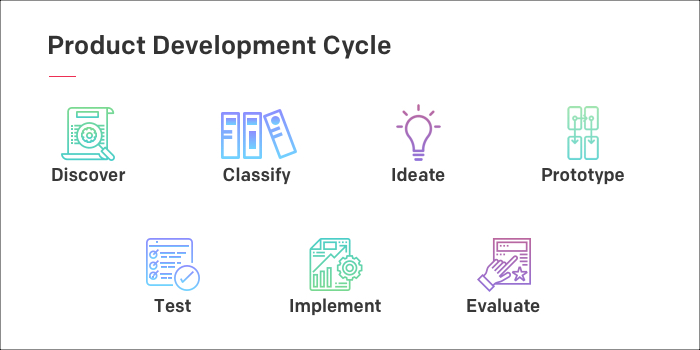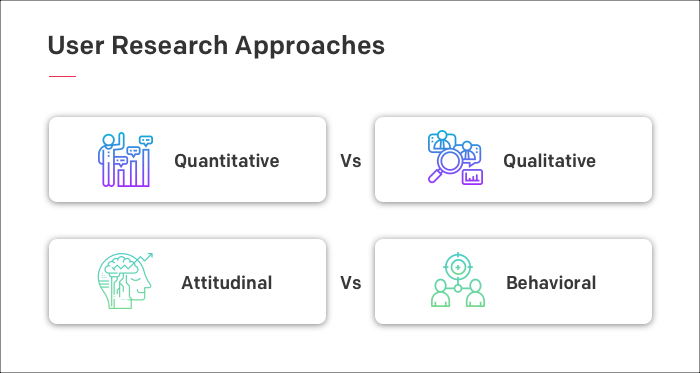There are millions of apps on app stores, but only a select few have been successful with users and most others experience a drop of interest right after their launch. As per research, an average individual uses close to 25 apps per month, of which 96% of the time is split between just 10 apps.
Forrester reports that 70% of the projects fail due to lack of user acceptance. This is mainly due to the apps poor user experience. As per a study from Bain & Company, 80% of companies feel they delivered an exceptional user experience while only 8% of customers agree. This is one of the main reasons why it’s crucial to gain customer insights with scientific techniques like user research and identify what users prefer than rely on assumptions or gut insights.
Let’s explore some of the key factors that make the user experience integral for enterprises to craft & deliver products and services that resonate with the pulse of their customers and prospects.
What is User Research?
User research is the foundation for creating a successful product or service. It keeps the user at the heart of the experience and helps in creating offerings that align with the user’s needs. Engineers and product designers have since centuries incorporated user feedback into their process, however, it was not until 1993 that the term “user experience” (UX) was coined by Don Norman during his time with Apple.
With the UX discipline evolving over the years, design teams and experts today incorporate various research techniques to enable decisions informed by the end-user rather than be led by assumptions.
The Significance of User Research
User research is a technique that is used to understand the needs, aspirations and behavior patterns of users through a series of quantitative and qualitative methods that help in simplifying the users’ challenges. A great UX Design is always embedded in great user research – influenced mainly by the user insights while balancing the other key technical aspects and priorities. It’s an excellent way to include the user in the design process for a more human & user-centered design process that is critical to product success.
However, most often teams and enterprises rush through and evade the user research process as it seems exhaustive and time-consuming. But, the implications of not applying user research as part of the product strategy are far too many. There is no one-size-fits-all approach that works in a hyper-personalized era that we are a part of.
While it is an elaborate process, it helps to include user research as part of your product & design strategy. Click to Tweet
“User-centered design means working with your users all throughout the project” — Don Norman
When is User Research needed?
The answer to this is actually anytime. At every stage of the product development cycle, user research helps in bringing new insights that will guide the product development cycle. Although each product development cycle is distinct, it can broadly be categorized under the following steps:

User research is broadly conducted in three distinct stages.
The Discovery Stage
The key goal during the early stage of the design process is to conduct exploratory research. As each project has a specific context and user group, the research should explore what is it that users actually need and understand what’s currently working and what’s not. A few research methods used at this stage include competitive analysis, benchmark studies, ethnographic research, one-on-one interviews, and focus groups.
The Development Stage
The next step is to assess the efficiency of the prototype developed and analyze if the product actually helps to solve the users’ challenges. Here are a few things to consider to ensure you’re on the right track.
- Do users understand how the prototype works?
- Have they been able to interact with the prototype?
- Were the users able to find what they were looking for?
- Do the features look & feel right?
Some of the user research methods used in this stage include card sorting, prototype testing, moderated and unmoderated usability testing, preference testing, and A/B testing.
The Execution Stage
Once the product prototype is ready to go live, the goal is to evaluate the efficiency of the product and assess if it meets the users’ needs. The objective is to measure the performance in order to optimize the experience. Feedback from users is crucial at this stage, as the users’ needs may have changed or evolved with time and the current prototype developed might not be the best fit. The key is to adapt and reiterate as per the current user needs. A few of the research methods used at this stage include surveys, bug reports, data analytics and more.
In a nutshell, user research is conducted at every stage of the product lifecycle depending on the end-objective. Let’s explore some of the user research methods and how they can be integrated as part of the product design strategy.
User Research Method Approach
The discipline of research is vast and multi-dimensional. Considering the various types of user research approaches and methods it can get overwhelming to focus on the one that you need to choose. Here are some of the important research methods and insights about when to use them:

Quantitative Research
Any type of research that can be measured numerically and used to understand the ‘what’ can be categorized under quantitative research. For example, “How many people have downloaded your app” or “What percentage of users clicked a particular app feature”. Quantitative research explores large samples of data like these to identify key trends and patterns. It gathers information from existing and potential customers with various sampling methods, online surveys, polls, questionnaires, analytics, and AB testing, etc. After a careful understanding of the results from quantitative research, it is much easier for product and business heads to assess the future of the product and make amendments to the product features accordingly.
Qualitative Research
Qualitative research unfolds the ‘why’ behind certain user behavior. It is a form of research that assimilates and works with non-numerical data and seeks to interpret meaning from this data with respect to specific user groups. For instance “Why do users have a particular affinity towards a product?” “Why was there a negative response to a product tagline?”. Qualitative research explores the opinions, attitudes, and behaviors of users and provides insights and context into why certain patterns and trends arise. The various research types used here include usability testing, one-on-one interviews, field studies, and customer calls.
For a holistic understanding of users and to be able to address their needs and concerns, it’s important to use a combination of quantitative and qualitative research methods. Both methods are integral to the product lifecycle and cannot be substituted for the other.
Attitudinal Research
Attitudinal research methods gather insights about the users’ feelings, thoughts, needs, attitudes, and motivations. It seeks to discover why users have specific feelings and attitudes towards an experience. For instance, it shares insights about whether users enjoyed engaging with a certain product. Research types include card sorting, surveys, focus groups, questionnaires, and participatory design.
However, there’s one downfall of this research method, especially in a focus group setting. As humans, we are self-conscious and concerned about how others might perceive us. The desire to belong to a certain group and be accepted also referred to as the ‘herd behavior’ can be so overpowering that the user’s responses might be swayed and not be completely honest. One way to keep a check and counter this is to split the focus group into smaller subsets without a moderator that’s observing their responses. Despite room for potential bias, this technique is incredibly valuable as users are invariably engaging with your digital assets and experiencing your brand and ultimately converting.
Behavioral Research
Behavioral research methods aim to evaluate what users actually do. This could help in gauging how users navigate through the website and provide quantitative data about their engagement with the website. For instance, it can provide insights into where users click after arriving at your homepage or identify if users fail to notice the key messaging displayed at the main menu section. Some of the techniques include eye-tracking, click-stream analysis, A/B testing, and usability studies.
As it is important to understand what users say vs. what they do, it is beneficial to conduct a combination of both attitudinal and behavioral research and derive actionable insights from both techniques in conjunction with each other, essentially to back up what users say as against what they do.
Enlisted here a few amongst the many user research types that brands need to consider to identify and assess user behavior and preferences.
Types of User Research Methods
Ethnographic Field Studies: A research type that gauges user behavior in their natural environments, where participants encounter the product or service.
Usability-Lab Studies: A one-on-one lab setting, where the participant is given a set of scenarios that helps in the identification of specific usage patterns of a product or service.
Participatory Design: An experiential method where participants are given to construct experiences that helps in clearly identifying what matters most to them and why.
Interviews: The researcher meets the participant on a one-on-one discussion to gain in-depth insights on a specific product/service or topic.
Eye Tracking: A research method that tracks the eyeball movement to identify how participants engage with the company’s digital assets and environments.
Clickstream Analysis: Data gathered by analyzing the record of the user clicks across all digital assets and platforms.
Focus Groups: Participant groups ranging from 3 –12 members are guided through a discussion about a fixed set of topics. Verbal and written feedback is documented through the course of the discussion.
Usability Benchmarking: Usability studies that are conducted with precise and predetermined measures of performance.
Moderated Remote Usability Studies: Usability studies conducted remotely via screen-sharing tools and remote monitoring capabilities.
Concept Testing: A research type that assesses if the product or service aligns with the value proposition of the concept to ensure it meets the needs of the target audience. This is conducted in both, group and one-on-one settings, offline and online.
Panel Studies: An identification of attitudinal changes using constant participant-base and assessing the individuals’ opinions at different times.
A/B Testing/Multivariate Testing: A research technique that evaluates the impact of the interaction between multiple variables, to identify the variant/s that have a greater impact on the desired user behavior.
UX Studies: Includes both quantitative & qualitative research methods to observe and track user behavior over a series of fixed goals and scenarios.
True-Intent Studies: a method that maps if users were able to accomplish their goal or intent and evaluate their subsequent behavior.
Diary/Camera Studies: A research study where participants are given a diary or camera to capture and describe the aspects of their lives that are relevant to a product or service including their thoughts and emotions.
Desirability Studies: Various visual-design alternatives are offered to participants to choose and associate each alternative from amongst the attributes selected from a predetermined list.
Card Sorting: Users are requested to classify items into groups and allocate categories for each group. This method typically applies the users’ mental models to refine the information architecture of a site.
Customer Feedback: Mostly commonly used research type, where participants are given open/close-ended review questions either online or offline.
Intercept Surveys: a survey that gathers user data during the use of a site or application.
Email Surveys: one of the most widely used research types that gathers user information via an email survey over a set of fixed scenarios.

Nothing sums it better – “Undervaluing User Research is a Deadly Disease”, says Jared Spool, a Maker of Awesomeness and co-Founder at Center Centre – UIE.
It is crucial to invest time and resources that bring you closer to your audience.
There is no comparison to the quality and impact of products that are crafted with user research insights. Click to Tweet
However, there is a huge overlap in the various types of user research methods that can be conducted. Selecting the most appropriate method/s to apply depends on the research goals you wish to accomplish. Though it is exhaustive and time-consuming, user research methods and their unique attributes can help enterprises and product heads gain useful insights that – inform the design process with specific and measurable goals, adapt a creative problem-solving approach and follow a user-centric design that can impact the overall business performance and growth.





